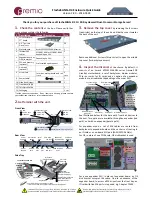
EELECTRON SPA
IN00M02WEBFI00020100_ADMIN_MANUAL
77 / 118
Execution order
During the simulation and compilation phases, the editor generates a LUA script that runs in cycles.
Tasks are concatenated in the script according to their order on the LOGIC TASKS summary page;
within each task, logic blocks also have their own execution order, indicated at the top right for each
block.
Under normal conditions, blocks are assigned an ascending order based on the order in which they
are placed in the program; however, you can force a different execution order as follows:
•
Select the block concerned
•
Open the details panel
•
Choose “MANUAL” as the sort order
•
Enter an order number, taking care to enter a number not yet used
Blocks with manual sorting are highlighted in yellow.
Finally, it is possible to reorder the blocks from top/left to bottom/right using the relevant button in
the toolbar.
Trigger
Under normal conditions, the logical module maintains the state of the exit objects based on the logic
state; as soon as these objects change state (for example, because they receive a command from
the bus, external to the logic), their state is immediately restored to that indicated by the logic.
This behaviour is not always desirable; in many situations, in fact, you may want to control an object
based on the change of state of other objects, but if this object is then controlled externally, you want
to keep it in the latter state. In other words, we want to create a logic that relates to “events”.
In this case, you must use the input and output TRIGGER nodes. Input triggers emit a pulse (i.e. a
value of 1 for a single script run cycle, then return to 0) each time a value is received on a given
object.
Output triggers, on the other hand, allow you to determine when to issue a command on an object;
whenever a pulse (value 1) is sent on this trigger, the value of the object is sent to the bus, even if it
has not changed since the previous execution cycle.
Therefore, if you want to change the logic example shown before (a simple AND between two KNX
widgets, which commands a third) so that the output object receives a command whenever the inputs
change, but can then change its status; if externally controlled, you must:
•
connect the two input TRG nodes of the first objects to the output TRG node of the third
Содержание Horizone Mini IN00M02WEB
Страница 2: ...EELECTRON SPA IN00M02WEBFI00020100_ADMIN_MANUAL 2 118 ...
Страница 11: ......
Страница 12: ......
Страница 15: ......
Страница 16: ......
Страница 17: ......
Страница 18: ......
Страница 19: ......
Страница 23: ......
Страница 24: ......
Страница 25: ......
Страница 26: ......
Страница 27: ......
Страница 28: ......
Страница 29: ......
Страница 30: ......
Страница 31: ......
Страница 32: ......
Страница 35: ......
Страница 36: ......
Страница 37: ......
Страница 38: ......
Страница 40: ......
Страница 44: ......
Страница 46: ......
Страница 47: ......
Страница 48: ......
Страница 49: ......
Страница 52: ......
Страница 53: ......
Страница 55: ......
Страница 56: ......
Страница 58: ......
Страница 59: ......
Страница 60: ......
Страница 62: ......
Страница 64: ......
Страница 66: ......
Страница 68: ......
Страница 70: ......
Страница 71: ......
Страница 75: ......
Страница 82: ......
Страница 83: ......
Страница 84: ......
Страница 85: ......
Страница 86: ......
Страница 87: ......
Страница 88: ......
Страница 89: ......
Страница 94: ......
Страница 104: ......
Страница 107: ......
Страница 108: ......
Страница 112: ......
Страница 113: ......
Страница 118: ......
















































